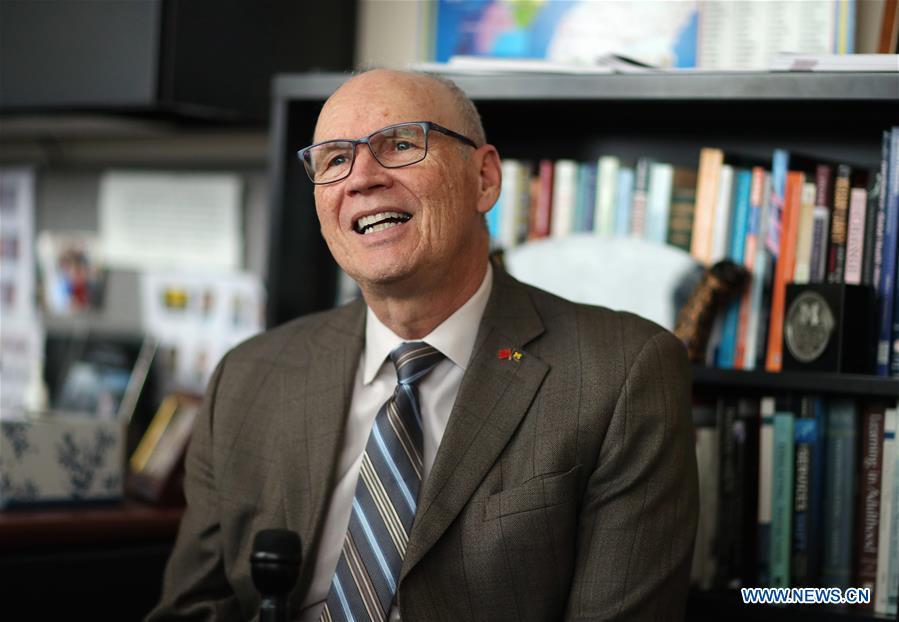
Joseph Kolars, a professor of health professions education at the University of Michigan, speaks during an interview with Xinhua at his office in Ann Arbor, Michigan, the United States, Nov. 13, 2019. (Xinhua/Wang Ping)
CHICAGO, Dec. 11 (Xinhua) -- Joseph Kolars has been to China over 50 times. From 1996 to 1999, he lived in Shanghai with his family and is the first non-Chinese citizen who got a doctor's license to practice in China.
Being a professor of health professions education at the University of Michigan (UM), Kolars helped develop a Western healthcare system with Ruijin hospital in Shanghai, and was on faculty at Shanghai Second Medical University during the time.
Kolars usually goes back to China three or four times a year, working with different institutions with different groups. "We've had a wonderful history of collaboration with China," he told Xinhua in an interview.
Kolars returned from China more than a month ago, where he attended the ninth annual Michigan Medicine-Peking University Health Science Center Joint Institute Symposium in Beijing.
In 2010, UM Health System started a joint institute for clinical and transnational research with Peking University Health Science Center. "The idea was for both of our institutions, the U.S. and China, to collaborate on big diseases that affect both of our populations and to do research to come up with findings that we can't do ourselves," Kolars said.
Since its establishment, the joint institute has grown to comprise 60 individual research projects co-led by researchers from each institution, and has to date garnered 67 publications and more than 24 million U.S. dollars in extramural funding in the United States alone. Collectively, the joint institute projects have about 128,000 patients under study in both China and the United States.
UM has been keeping a close relationship with China. In 1972, the Chinese table tennis delegation flew into Detroit and visited UM in Ann Arbor on one of its first stops in the United States, in response to an invitation from UM's table tennis team.
"Ping-Pong Diplomacy" is just an example of the roles UM faculty and professors have played in promoting relations between the United States and China all the way along. Besides building bridges, the university in the Midwest began taking advantage of the opportunities stemming from closer communications between the two countries.
Shortly after then U.S. President Richard Nixon's groundbreaking trip to China, UM Psychology Professor Harold Stevenson visited China along with a group of developmental psychologists, kicking off a long-standing collaboration between UM and the Chinese Academy of Sciences.
Today, UM collaborates with about 30 different schools in China. Mary Gallagher, a professor of political science at UM, first went to China as an undergraduate student 30 years ago.
"Change in China is very dramatic. The social transformation, the economic development, it is just unprecedented in the world," she admired.
"What we've seen as China has changed is China's role in the world has become more important," said Gallagher, now director of the Center for Chinese Studies at UM which was launched in 1961. "We have more students and more faculties who want to work on China, who want to study China, who want to understand China."
UM Center for Chinese Studies now has about 45 faculty associates carrying out research on China. Each of those faculty members has connections and programs with China and Chinese universities, Chinese local governments and ministries. This wide-ranging, deep connection with China has consolidated the center's position among all China study centers in the United States.
Alan Deardorff, a professor of international economics and public policy at UM, has been to China a dozen times. He recalls his first trip to China in 2000.
"There's an organization that takes Americans abroad and people from abroad to America, and they organized a trip and they asked me to lead it," Deardorff said.
"Since then I've been there more on business," he added. "We have a sort of exchange arrangement with Renmin University in Beijing, and I traveled there twice because of that arrangement. Other times I'd been there for conferences, many, many conferences in different places and some teaching too."
Deardorff said he was impressed by China's fast development.
"I found it reasonably easy to get around in China. It seemed like by the time I went, the infrastructure had surpassed many other developing countries. And of course it's gotten far, far better since then," he went on.
Kolars is very positive about UM's collaboration with China. "It's a great model, and we're very pleased with the design and the implementation," he said.
"We haven't seen any dampening of enthusiasm for our collaborations with China. There are more people who are applying for collaboration grants from UM with China. Not less, more, and we see more enthusiasm from China."
The memorandum of understanding (MoU) for the Joint Institute between UM and Peking University was signed in 2010, and it was renewed in 2015 and will be further renewed for another five years.
"Our expectation is that we'll always continue to sign five-year renewals as long as the win-win is working, and we anticipate the win-win will work for a long time," Kolars said.